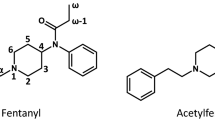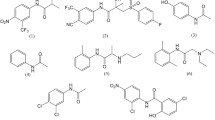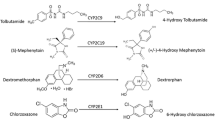Abstract
The metabolism of albendazole (ABZ), a benzimidazole anthelminthic, was studied in either microsomal preparations of human liver biopsies or cultured human hepatoma cell lines. Metabolites were analyzed by HPLC. Our data show that microsomes from human biopsies and two human cell lines, HepG2 and Hep3B, oxidize the drug to the sulfoxide very efficiently, whereas the third cell line tested, SK-HEP-1, does not. Both cytochrome P-450 dependent monooxygenases and favin-containing monooxygenases appear to be involved in human ABZ metabolism. Using the cell line displaying the highest ABZ-metabolizing activity, HepG2, the cytotoxic and the inducing effects of the parent drug ABZ and of two primary metabolites, the sulfoxide and the sulfone were studied. These three chemicals provoked a rise in mitotic index resulting from cell division blockage at the prophase or at the metaphase (ABZ metabolites) stage, and ABZ was more cytotoxic than its metabolites. With regard to enzyme-inducing effects, our data clearly demonstrate that the sulfoxide and, to a lesser degree, the sulfone are potent inducers of some drug metabolizing enzymes (i.e., cytochrome P-488 dependent monooxygenases and UDP glucuronyltransferase), whereas ABZ fails to increase and even slightly decreases these enzymatic activities. In conclusion, the HepG2 human hepatoma cell line appears to be suitable for the study of many parameters of metabolism and action of ABZ and other structurally related compounds in humans.
Similar content being viewed by others
Abbreviations
- ABZ:
-
albendazole
- B[a]P:
-
benzo[a]pyrene
- HPLC:
-
high-performance liquid chromatography
- MC:
-
3-methylcholanthrene
- MFO:
-
mixed-function oxidase
- UDPGT:
-
UDP-glucuronyltransferase
References
ADEN, D.P., FOGEL, A., PLOTKIN, S.A., DAMJANOV, I. and KNOWLES, B.B. (1979). Controlled synthesis of HBsAg in a differentiated human liver carcinoma-derived cell line. Nature 282:615–616.
ASTROM, A., MANER, S. and DEPIERRE, J.W. (1987). Induction of liver microsomal epoxide hydrolase, UDP-glucuronyltransferase and cytosolic glutathione transferase in different rodent species by 2-acetylaminofluorene or 3-methylcholanthrene. Xenobiotica 17:155–163.
BARROWMAN, M.M., MARRINER, S.E. and BOGAN, J.A. (1984). The binding and subsequent inhibition of tubulin polymerisation in ascaris suum (in vitro) by benzimidazole anthelmintics. Biochem. Pharmacol. 33:3037–3040.
BARTSCH, H., KUROKI, T., ROBERFROID, M. and MALAVEILLE, C. (1982). Metabolic Activation System in vitro for Carcinogen/Mutagen Screening Tests. Chemical Mutagens 7:95–161.
BAST, A., SAVENIJE-CHAPEL, E.M. and KROES, B.H. (1984). Inhibition of monoxygenase and oxidase activity of rat hepatic cytochrome P-450 by H2 receptor blockers. Xenobiotica 14:399–408.
BURKE, M.D. and MAYER, R.T. (1974). Ethoxyresorufin: Direct fluometric assay of a microsomal O-dealkylation, which is preferentially induced by 3-methylcholenthrene. Drug Metab. Dispos. 2:583–588.
COMER, P., CHENGELIS, C.P., LEVIN, S. and KOTSONIS, F.N. (1985). Changes in thyroidal function and liver UDP glucuronyltransferase activity in rats following administration of a novel imidazole (SC37211). Toxicol. Appl. Pharmacol. 80:427–436.
DAVIS, A., PAWLOSKI, Z.S. and DIXON, H. (1986). Multicentre clinical trials of benzimidazolecarbamates in human echinococcosis. WHO Bulletin 64:383–388.
DAWSON, J.R., ADAMS, D.J. and WOLF, C.R. (1985). Induction of drug metabolizing enzymes in human liver cell line HepG2. FEBS Letters 183:219–222.
DEARFIELD, K.L., JACOBSON-KRAM, D., BROWN, N.A. and WILLIAMS, J.R. (1983). Evaluation of a human hepatoma cell line as a target cell in genetic toxicology. Mutat. Res. 108:437–449.
DECAD, G.M., HSIEH, D.P. and BYARD, J.L. (1977). Maintenance of cytochrome P-450 and metabolism of aflatoxin B1 in primary hepatocyte cultures. Biochem. Biophys. Res. Commun. 78:279–287.
DELATOUR, P., PARISH, R. and GYURIK, R.J. (1981). Albendazole: a comparison of relay embryotoxicity with embryotoxicity of individual metabolites. Am. Rech. Vet. 12:159–167.
DELATOUR, P., GARNIER, F., BENOIT, E. and LONGIN, C. (1984). A correlation of toxicity of albendazole and of oxfendazole with their free metabolites and bound residues. J. Vet. Pharmacol. Ther. 7:139–145.
DELATOUR, P. and PARISH, R. (1986). Benzimidazole anthelmintics and related compounds: Toxicity and evaluation of residues. Adv. Vet. Sci. Comp. Med. 31:175–204.
DIAMOND, L., KRUSZEWSKI, F., ADEN, D.P., KNOWLES, B.B. and BAIRD, W.M. (1980). Metabolic activation of benzo[a]pyrene by a human hepatoma cell line. Carcinogenesis 1:871–875.
DICKSON, B. (1983). Summary of albendazole clinical trials in Middle East and Africa. In: Albendazole in Helminthiasis. pp. 79–85. (International Congress and Symposium, Series 61). The Royal Society of Medicine, London.
DOUCH, P.G. and BUCHANAN, L.L. (1979). Some properties of sulfoxidases and sulfoxide reductases of the cestode Monieza expansa, the nematode Ascaris suum and mouse liver. Xenobiotica 9:675–679.
DRAGACCI, S., THOMASSIN, J., MAGDALOU, J., SOUHAILI-EL AMRI, H., BOISSEL, P. and SIEST, G. (1987). Properties of human hepatic UDP-glucuronyltransferases. Relationship to other inducible enzymes in patients with cholestasis. Eur. J. Clin. Pharmacol. 32:485–491.
FARGETTON X., GALTIER, P. and DELATOUR, P. (1986). Sulfoxidation of albendazole by a cytochrome P-450-independent monooxygenase from rat liver microsomes. Vet. Res. Commun. 10:317–324.
FOGH, J. and TREMPE, G. (1975). New human tumor cell lines. In: Fogh J. (ed). Human tumor cells in vitro. Plenum Press, New York, pp. 115–159.
GALTIER, P., ALVINERIE, M. and DELATOUR, P. (1986). In vitro sulfoxidation of albendazole by ovine liver microsomes: Assay and frequency of various xenobiotics. Am. J. Vet. Res. 47:447–452.
GHERSI-EGEA, J.F., WALTHER B., DECOLIN, D., MINN, A. and SIEST, G. (1987). The activity of 1-naphtol-UDP-glucuronyltransferase in the brain. Neuropharmacology 26:367–372.
GYURIK, R.J., CHOW, A.W., ZABER, B., BRUNER, E.L., MILLER, J.A., VILLANI, A.J., PETKA, L.A. and PARISH, R. (1981). Metabolism of albendazole in cattle, sheep, rats and mice. Drug Metab. Dispos. 9:503–508.
HANIGAN, M.H. and PITOT, H.C. (1985). Gamma-glutamyltranspeptidase. Its role in hepatocarcinogenesis. Carcinogenesis 6:165–172.
HOLDER, G.M., LITTLE, P.J., RYAN, A.J. and WATSON, T.R. (1976). Inhibitors of hepatic mixed function oxidases. II. Some benzimidazole, benzoxazole and benzothiazole derivatives. Biochem. Pharmacol. 25:2747–2750.
HUBERMAN, E. and SACHS, L. (1974). Cell-mediated mutagenesis of mammalian cells with chemical carcinogens. Int. J. Cancer 13:326–333.
IRELAND, C.M., GULL, K., GUTTERIDGE, W.E. and POGSON, C.I. (1979). The interaction of benzimidazole carbamates with mammalian microtubule protein. Biochem. Pharmacol. 28:2680–2682.
JEFCOATE, C.R., GAYLOR, G.L. and CALABRESE, R.L. (1980). Ligand interaction with cytochrome P-450. I. Binding of primary amine. Biochemistry 8:3455–3463.
JENSEN, J.C. and GUGLER, R. (1986). Inhibition of human liver cytochrome P-450 by omeprazoler. Br. J. Clin. Pharm. 21:328–330.
KOOP, D.R., CRUMP, B.L., NORDBLOM, G.D. and COON, M.J. (1985). Immunochemical evidence for induction of the alcohol oxidizing cytochrome P-450 of rabbit liver microsomes by diverse agents ethanol, imidazole, trichloroethylene, acetone, pyrazole and isoniazid. Proc. Natl. Acad. Sci. 82:4065–4069.
LIMBOSCH, S. (1983). Benzo(a)pyrene- and aldrin-metabolizing activities in cultured human and rat hepatoma cell lines. J. Natl. Cancer Inst. 71:281–286.
LOWRY, O.H., ROSEBROUGH, N.J., FARR, A.L. and RANDALL, R.J. (1951). Protein measurement with the Folin phenol reagent. J. Biol. Chem. 193:265–275.
MARRINER, S.E. and BOGAN, J.A. (1980). Pharmacokinetics of albendazole in sheep. Am. J. Vet. Res. 41:1126–1129.
MARRINER, S.E., MORRIS, D.L., DICKSON, B. and BOGAN, J.A. (1986). Pharmacokinetics of albendazole in man. Eur. J. Pharmacol. 30:705–708.
OWENS, I.S. (1977). Genetic regulation of UDP-glucuronyltransferase induction by polycyclic aromatic compounds in mice. J. Biol. Chem. 252:2827–2833.
PENICAULT, B., MAUGEIN, P.H., MAISONNEUVE, H. and ROSSIGNOL, J.F. (1983). Pharmacocinetique et metabolisme urinaire de l'albendazole chez l'homme. Bull. Soc. Path. Ex. 76:698–708.
PRICHARD, R.K., HENESSY, D.R., STEEL, J.N. and LACEY, E. (1985). Metabolite concentrations in plasma following treatment of cattle with five anthelmintics. Res. Vet. Sci. 39:173–178.
RENDIC, S., RUF, H.H., WEBER, P. and KAJFEZ, F. (1984). Cimetidine and ranitidine: their interaction with human liver microsomes and with purified cytochrome P-450. European J. Drug Metab. Pharmacokin. 9:195–200.
RICHARDS, W.L., TSUKODA, Y. and VAN POTTER, R. (1982). Phenotypic diversity of glutamyltranspeptidase activity and protein secretion in hepatoma cell lines. Cancer Res. 42:1374–1383.
ROSSIGNOL, J.F. (1983). Double blind placebo-controlled clinical trials of albendazole: World Summary. In: Albendazole in Helminthiasis, pp. 79–85. (International Congress and Symposium, Series 61). The Royal Society of Medicine, London.
SAIMOT, A.G., CREMIEUX, A.C., HAY, L.M., MEULEMANS A., GIOVANANGELI, M.D., DELAITRE, B. and COULAUD, J.P. (1983). Albendazole as a potential treatment for human hydatidosis. The Lancet 17:652–656.
SASSA, S., SUGITA, O., GALBRAITH, R.A. and KAPPAS, A. (1987). Drug metabolism by the human hepatoma cell, HepG2. Biochem. Biophys. Res. Comm. 143:52–57.
SIEST, G., BAGREL, D., LEVY, M., FEBVRE, N., FOURNEL-GIGLEUX, S., ROLIN, S., SABOLOVIC, N., WELLMAN, M., GALTEAU, M.M. and TOYODA, Y. (1988). The use of hepatoma cells in culture as an alternative for study of drug metabolizing enzymes. In: Metabolism of Xenobiotics (J.W. Gorrod, H. Oelschlager and J. Caldwell, eds.), pp. 285–293. Taylor and Francis, London-New York-Philadelphia.
SOUHAILI-EL AMRI, H., FARGETTON, X., DELATOUR, P. and BATT, A.M. (1987). Sulphoxidation of albendazole by the FAD-containing and cytochrome P-450 dependent monooxygenases from pig liver microsomes. Xenobiotica 17:1159–1168.
SOUHAILI-EL AMRI, H., FARGETTON, X., BENOIT, E., TOTIS, M. and BATT, A.M. (1988). Inducing effect of albendazole on rat liver drug metabolizing enzymes and metabolite pharmacokinetics. Toxicol. Appl. Pharmacol. 92:141–149.
SZASZ, G. (1969). A kinetic photometric method for serum gamma-glutamyltranspeptidase. Clin. Chem. 19:124–126.
THEODORIDES, V.J., GYURIK, R.J., KINGSBURY, W.D. and PARISH, R.C. (1976). Anthelmintic activity of albendazole against liver flukes, tapeworms, lung and gastrointestinal roundworms. Experientia 32:702–703.
ZIEGLER, D.M. (1980). Microsomal flavin containing monooxygenase, oxygenation of nucleophilic nitrogen and sulfur containing compounds. In: Enzymatic Basis of Detoxification. W. B. Jakoby, ed., pp. 201–227. Academic Press, New York.
Author information
Authors and Affiliations
Rights and permissions
About this article
Cite this article
Rolin, S., Amri, H.SE., Batt, AM. et al. Study of the in vitro bioactivation of albendazole in human liver microsomes and hepatoma cell lines. Cell Biol Toxicol 5, 1–14 (1989). https://doi.org/10.1007/BF00141060
Received:
Accepted:
Issue Date:
DOI: https://doi.org/10.1007/BF00141060




